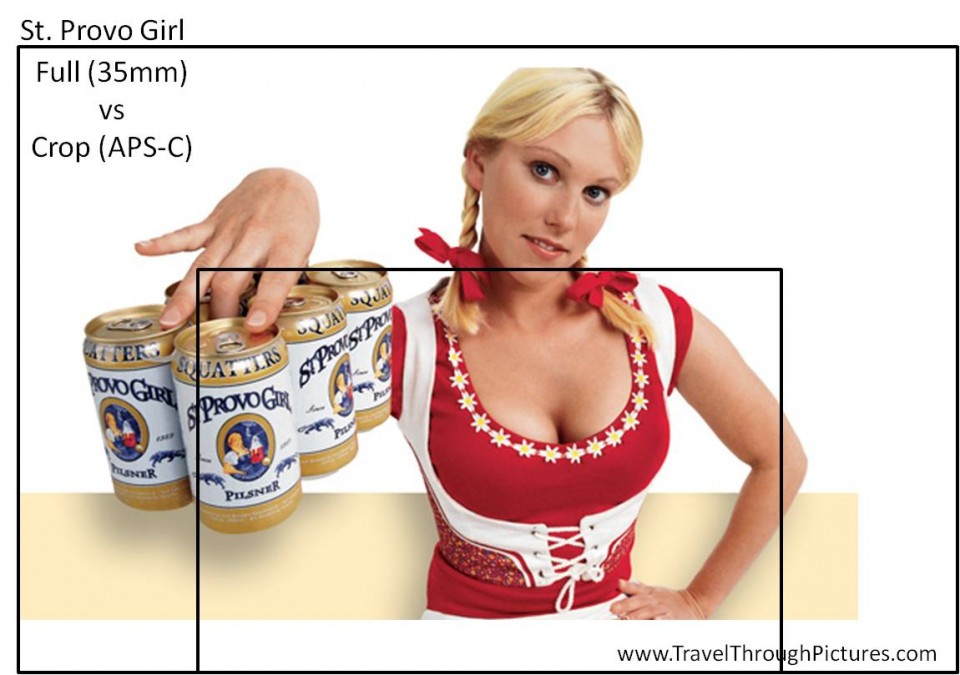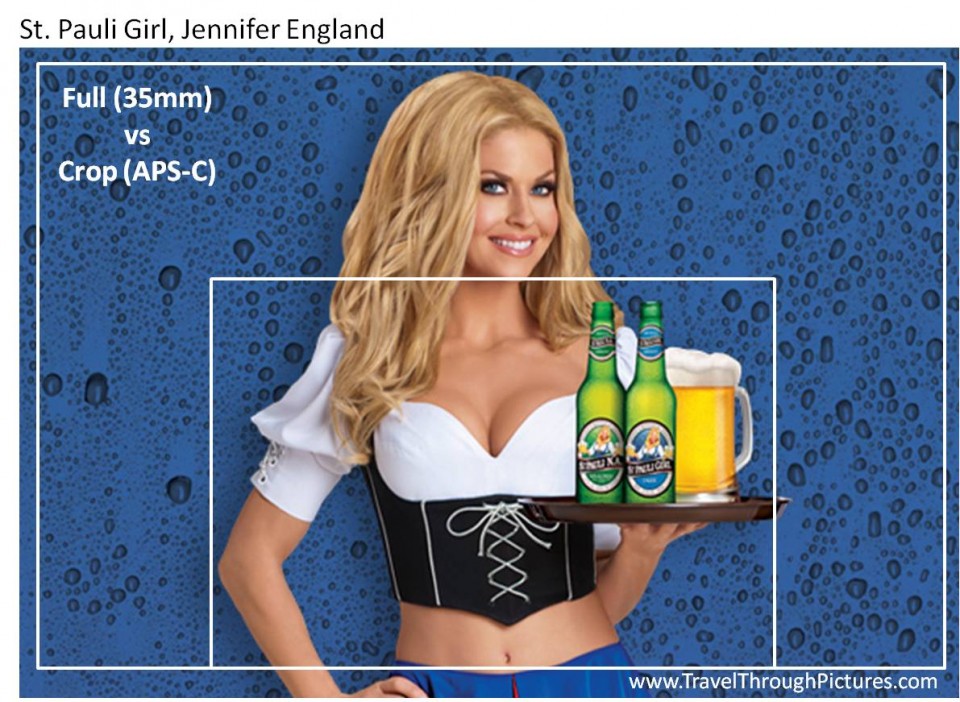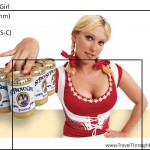Crop vs Full Sensors and Zoom
I thought you would like to see how a Canon crop sensor DSLR compares to a full sensor camera. This can be handy if you are considering buying a new lens and were wondering what was the impact of your camera’s sensor on the lens’s specified length and zoom.
To show you the differences, I put on my tried and true beer goggles to get me to the truth. I suspect after seeing my examples above, only a crop sensor camera will do for ½ the world’s population. As you can see from the crop lines in the beer girls above, a crop sensor “appears” to give more zoom. I say “appears” as technically you are not getting more zoom, your lens size in millimeters does not change, but you are seeing less of the big picture and that gives you, in effect, more zoom. If your camera has a full sensor, you can just crop it down on your PC later and get the same effect. I do like this zoom effect as it really makes you want to jump out and grab that beer.
What is a full and crop Sensor?
A camera sensor is considered “full” if it is the size of the old 35mm film standard. Crop sensors are those that are smaller than full size and are in most consumer DSLRs. Canon’s DSLRs come in a few flavors of sensor sizes, but the two primary sizes are called Full and APS-C size. If you have a Rebel, you have an APS-C sized sensor. Most consumer DSLRs such as the Canon 7D and the Rebel series are crop, APS-C sized sensor cameras and only the most expensive camera bodies have full sensors in them. Nikon’s sensor sizes are similar. I added other common and Micro 4/3rds formats to the diagram here and a Canon point and shoot sensor just for reference. Check your camera’s specifications in the owner’s manual for sensor information about what exactly is in your camera.
Should You Care?
In short, no. There are only three reasons you may care, 1) You used to shoot 35mm film cameras and your brain is still wired this way, 2) you are considering buying another camera with a sensor size different from the one you own, or 3) you shoot pictures of beer girls for a living. For me, I still think in 35mm film relationships so when I put a 50mm lens to my face, I expect to see a certain amount of perspective. People like me have to recalculate to understand what lenses are like on common crop sensor cameras. If you are considering moving up to say a full frame camera, you do have to keep in mind that what a 200mm lens does for zooming is not going to be the same as your crop sensor camera. You will loose length and have to rethink the value of your lens collection to you… assuming your lenses will even fit on a full frame camera. But if you are not 1 or 2 above, you should not care at all as this is all meaningless. Your brain is being wired for your sensor size and that is OK. It only matters if you change sensor sizes.
Zoom, Sensor Size, and Crop Factor
When a camera has a smaller sensor, it will appear to have more zoom than a full sensor camera with the same size lens. Many folks who shoot birds or those who want more reach, like crop sensor cameras because images look closer given the same lens. To know what these smaller, crop sensor cameras do to your lens, you can use what is called a crop factor to help shed some light on this. The crop factor in most of Canon’s consumer cameras is 1.6x. You take the lens size in mm and just multiply by the crop factor and this tells you the lens length you really will get. I put some of the common Canon lens sizes in the chart below for those who were sick that day in math class.
Sensor Size and Image Quality
This is a very misunderstood issue and in short, all the DSLRs on the market today have great image quality. To hit a price point or satisfy the desires of a target market, engineers make many many tradeoffs and to make matters even more difficult, the state of the art is always advancing so what is true today may not be true tomorrow. But to give you a quick answer, the following is mostly true:
- Full or larger sensors are generally considered to have superior image quality than smaller sensors
- Full sensors provide for a shallower depth of field than crop sensors and are therefore desired by those who want to create arty pictures with blurred backgrounds
- Crop, or smaller sensors, are desired by those who want more reach or zoom for their dollar
- Larger sensors tend to be less noisy and have better high ISO performance than smaller sensors
- Larger sensors are way more expensive to manufacture than smaller ones and the cameras that have them are very expensive
- Smaller sensors do not require the larger lenses of full sensor cameras so manufacturers created a line of smaller, less expensive lenses for these cameras (Canon calls these EF”s” lenses but the larger EF lenses will fit all their DSLR cameras)
If you really want to understand why larger sensors generally have better image quality than smaller sensors, you need to dig into what is pretty sophisticated science. For example, image quality and digital noise have more to do with pixel size and pixel density than overall sensor size. I will stop here as this blog article will drift way off course for what I intended. But be careful in making generalized statements about image quality based on sensor size, as the only thing that matters is what the camera can produce. Image quality has way more to do with the combination of engineering decisions, software design, and cost/benefit tradeoffs the engineers deal with for a given camera body. And, in general, newer is better than older…. well most of the time anyway as technology constantly advances.
What do I Like?
I like beer. If you are talking cameras, I am amazed with and love the pictures that my full sensor 5D MkII camera makes. The first pictures I shot with this camera shocked me… “I did that?!” If you couple a wide f/2.8 or more aperture lens with a full sensor camera, you can create dreamy, blurred environments for a subject. Once you shoot with a full sensor camera, it is hard to give it up as it really is an artist’s tool.
As long as I can afford it, I will buy large sensor cameras. But to be honest with myself, I can’t tell what sensor produced what picture for things published on the internet. On my big, bright, calibrated computer monitor, differences become apparent but I am the only person who sees my pictures this way. Smart phone pictures, made with their tiny sensors and lenses, always look lousy to me being grainy and somewhat… well odd. But in general, big sensors coupled with big glass make better pictures and this means spending more money (are you surprised at this?).
So should you spring for a full sensor camera? Only you can make that decision, but unless you intend to really get into this hobby, forget it, save your money, and buy some cool fun lenses instead. You won’t know the difference and you may appreciate the extra reach of a crop sensor camera.






